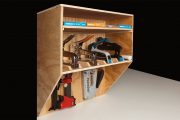(BPT) – As the world of interior design continues to evolve, homeowners and decorators alike continue to explore innovative ways to elevate their living spaces. The past few years have welcomed a wave of fresh wall and ceiling trends that aim to transform home décor, including the most recent revival of textured walls and ceilings.
“Homeowners are always looking for fresh and simple ways to incorporate eye-catching elements into their home,” said Raquel Beckett, senior product manager at DAP. “While texture is not a new concept, it is a novel way to effortlessly add a sense of depth and dimension to any room. We are seeing it in everything from accent walls to full covered ceilings.”
One of the simplest and most cost-effective ways to add texture to walls and ceilings is with aerosol products. Here’s how to achieve this sought-after look with spray texture:
Select a texture.
Choosing the right texture for your walls and ceilings can significantly impact the overall atmosphere of your living spaces. Texture can help hide wall imperfections. Some of the most popular spray texture options are Knockdown, Orange Peel and Popcorn. Knockdown offers a more subtle and understated approach with a textured surface that features flattened peaks. It’s an excellent option if you desire a textured look without an overpowering visual effect. Orange Peel is a classic and versatile choice with a texture that mimics the surface of an orange peel. It’s subtle, yet visually appealing, and suits a wide range of home decors. Popcorn is perfect for those seeking a textured look with a vintage touch. It creates a bumpy, stippled appearance that adds depth and character to ceilings. Homeowners can easily achieve any of these compositions through aerosol spray texture applications available from local home improvement stores.
Prep the area.
Before getting started, take time to properly prep the wall or ceiling area. Use a drop cloth or sheet to cover the floor or any furniture, then clean the surface area and allow it to dry completely. If there is existing texture on the area, be sure to remove it prior to applying the new texture. Lastly, practice the application before jumping in to ensure you are comfortable with the spray applicator to achieve the best results.
Apply texture.
Use a spray texture product that is easy to apply and will give you a consistent level of texture throughout the area you are covering. DAP’s line of 2in1 Wall and Ceiling Spray Texture is an ideal choice for both pros and DIYers tackling texture. The aerosol cans feature Aim Tech technology that offers a patent pending 60-degree adjustable nozzle to easily cover vertical, overhead and hard-to-reach areas. The nozzle also allows you to select a fine, medium or heavy level of texture when sprayed. Hold the can approximately 12 to 18 inches away from the surface using intermittent bursts, sweeping across the area in a quick, continuous motion.
Sand and paint.
Finish your project by sanding or painting the textured area. DAP Spray Texture only needs 30 minutes of dry time for water-based formulas and five minutes for oil-based, before you can sand or paint. Be sure to follow your paint manufacturer’s instructions on best results for applying paint to textured surfaces. If you are applying the texture on the exterior of the home, you’ll need to use an exterior grade paint.
With the new Spray Texture line from DAP, anyone looking to repair their textured areas or spruce up their living spaces can do so easily. For more tips and products to help create your wall or ceiling texture, visit DAP.com/spray-texture.


